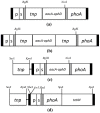Genes found essential in other mycoplasmas are dispensable in Mycoplasma bovis
- PMID: 24897538
- PMCID: PMC4045577
- DOI: 10.1371/journal.pone.0097100
Genes found essential in other mycoplasmas are dispensable in Mycoplasma bovis
Abstract
Mycoplasmas are regarded to be useful models for studying the minimum genetic complement required for independent survival of an organism. Mycoplasma bovis is a globally distributed pathogen causing pneumonia, mastitis, arthritis, otitis media and reproductive tract disease, and genome sequences of three strains, the type strain PG45 and two strains isolated in China, have been published. In this study, several Tn4001 based transposon constructs were generated and used to create a M. bovis PG45 insertional mutant library. Direct genome sequencing of 319 independent insertions detected disruptions in 129 genes in M. bovis, 48 of which had homologues in Mycoplasma mycoides subspecies mycoides SC and 99 of which had homologues in Mycoplasma agalactiae. Sixteen genes found to be essential in previous studies on other mycoplasma species were found to be dispensable. Five of these genes have previously been predicted to be part of the core set of 153 essential genes in mycoplasmas. Thus this study has extended the list of non-essential genes of mycoplasmas from that previously generated by studies in other species.
Conflict of interest statement
Figures



Similar articles
-
Genes required for survival and proliferation of Mycoplasma bovis in association with host cells.Appl Environ Microbiol. 2024 Jul 24;90(7):e0068724. doi: 10.1128/aem.00687-24. Epub 2024 Jun 12. Appl Environ Microbiol. 2024. PMID: 38864628 Free PMC article.
-
Mycoplasma bovis shares insertion sequences with Mycoplasma agalactiae and Mycoplasma mycoides subsp. mycoides SC: Evolutionary and developmental aspects.FEMS Microbiol Lett. 2005 Apr 15;245(2):249-55. doi: 10.1016/j.femsle.2005.03.013. FEMS Microbiol Lett. 2005. PMID: 15837379
-
The complete genome sequence of Mycoplasma bovis strain Hubei-1.PLoS One. 2011;6(6):e20999. doi: 10.1371/journal.pone.0020999. Epub 2011 Jun 22. PLoS One. 2011. PMID: 21731639 Free PMC article.
-
Comparative geno-plasticity analysis of Mycoplasma bovis HB0801 (Chinese isolate).PLoS One. 2012;7(5):e38239. doi: 10.1371/journal.pone.0038239. Epub 2012 May 31. PLoS One. 2012. PMID: 22693604 Free PMC article.
-
Proteomics analysis and its role in elucidation of functionally significant proteins in Mycoplasma bovis.Microb Pathog. 2017 Oct;111:50-59. doi: 10.1016/j.micpath.2017.08.024. Epub 2017 Aug 18. Microb Pathog. 2017. PMID: 28826762 Review.
Cited by
-
Development and host compatibility of plasmids for two important ruminant pathogens, Mycoplasma bovis and Mycoplasma agalactiae.PLoS One. 2015 Mar 6;10(3):e0119000. doi: 10.1371/journal.pone.0119000. eCollection 2015. PLoS One. 2015. PMID: 25746296 Free PMC article.
-
Genes required for survival and proliferation of Mycoplasma bovis in association with host cells.Appl Environ Microbiol. 2024 Jul 24;90(7):e0068724. doi: 10.1128/aem.00687-24. Epub 2024 Jun 12. Appl Environ Microbiol. 2024. PMID: 38864628 Free PMC article.
-
The Mycoplasma spp. 'Releasome': A New Concept for a Long-Known Phenomenon.Front Microbiol. 2022 Apr 15;13:853440. doi: 10.3389/fmicb.2022.853440. eCollection 2022. Front Microbiol. 2022. PMID: 35495700 Free PMC article. Review.
-
SynMyco transposon: engineering transposon vectors for efficient transformation of minimal genomes.DNA Res. 2019 Aug 1;26(4):327-339. doi: 10.1093/dnares/dsz012. DNA Res. 2019. PMID: 31257417 Free PMC article.
-
Rescue of mutant fitness defects using in vitro reconstituted designer transposons in Mycoplasma mycoides.Front Microbiol. 2014 Jul 23;5:369. doi: 10.3389/fmicb.2014.00369. eCollection 2014. Front Microbiol. 2014. PMID: 25101070 Free PMC article.
References
-
- Caswell JL, Archambault M (2007) Mycoplasma bovis pneumonia in cattle. Animal Health Research Reviews 8: 161–186. - PubMed
-
- Dybvig K, Voelker LL (1996) Molecular biology of mycoplasmas. Annual Review of Microbiology 50: 25–57. - PubMed
-
- Halbedel S, Stulke J (2007) Tools for the genetic analysis of Mycoplasma. International Journal of Medical Microbiology 297: 37–44. - PubMed
-
- Minion FC (2002) Molecular pathogenesis of mycoplasma animal respiratory pathogens. Frontiers in Bioscience 7: d1410–1422. - PubMed
Publication types
MeSH terms
Substances
LinkOut - more resources
Full Text Sources
Other Literature Sources

